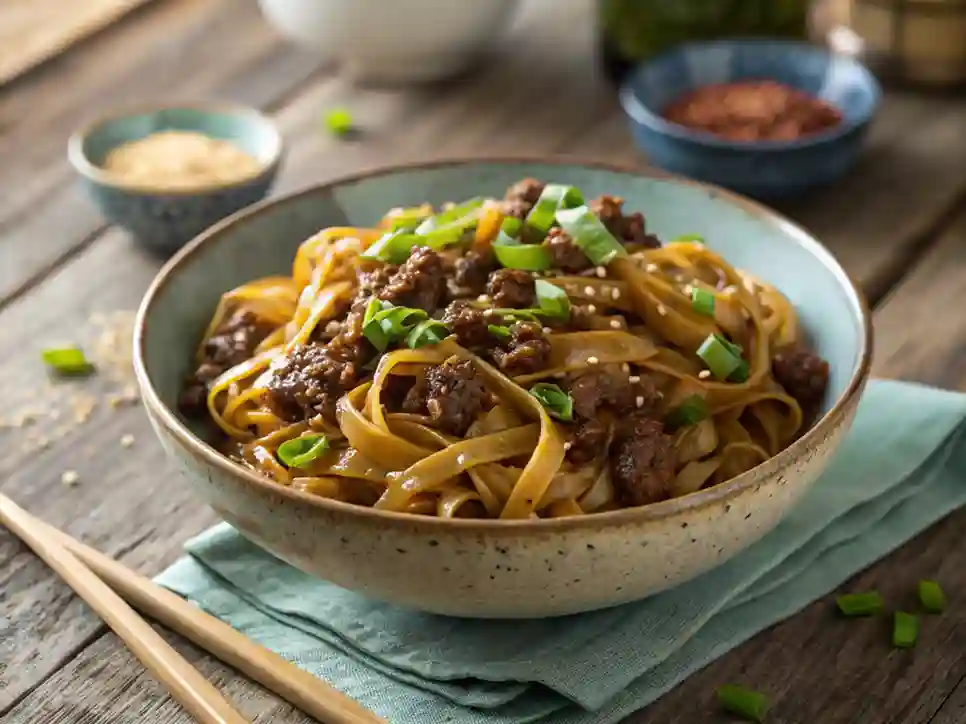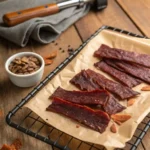If you’re craving a savory stir-fry dinner that’s both comforting and bursting with flavor, this easy Mongolian Ground Beef noodle dish is just what you need. Combining soy sauce, garlic, ginger, and a touch of brown sugar, this recipe fuses the rich, sweet-and-spicy allure of traditional Mongolian beef with the ease of cooking ground meat.
Below, you’ll find all the details on why this article is worth reading, how to make Mongolian ground beef, and plenty of tips for creating a family-friendly meal in less than 30 minutes. By the end, you’ll have a delicious plate of Mongolian ground beef and noodles that’s ideal for any busy evening.
Table of Contents
1. How to Make Mongolian Ground Beef
When you think of Mongolian beef, you might imagine thinly sliced flank steak quickly stir-fried with garlic and ginger in a sweet-and-spicy sauce. But if you want all that flavor without the extra slicing prep, then you’ll love to make Mongolian ground beef instead. Ground beef often cooks faster, and it’s perfect for absorbing bold, sweet, and tangy flavors like soy sauce, hoisin sauce, and brown sugar. This approach also works seamlessly in a variety of ground beef recipes, making it incredibly versatile for family dinners.
In this recipe for Mongolian ground beef, we pair tender, easy ground beef with a homemade sauce made from minced garlic mixed with rice vinegar that enhances the flavor. You’ll notice that this version of Mongolian ground beef noodles blends the same flavors as the traditional Mongolian beef you’d find in your favorite restaurant—yet it’s made with ground beef for more convenience.
Plus, with the quick cooking time, you can enjoy a hearty meal of beef noodles or beef and noodles any night of the week without much hassle.
2. Ingredients
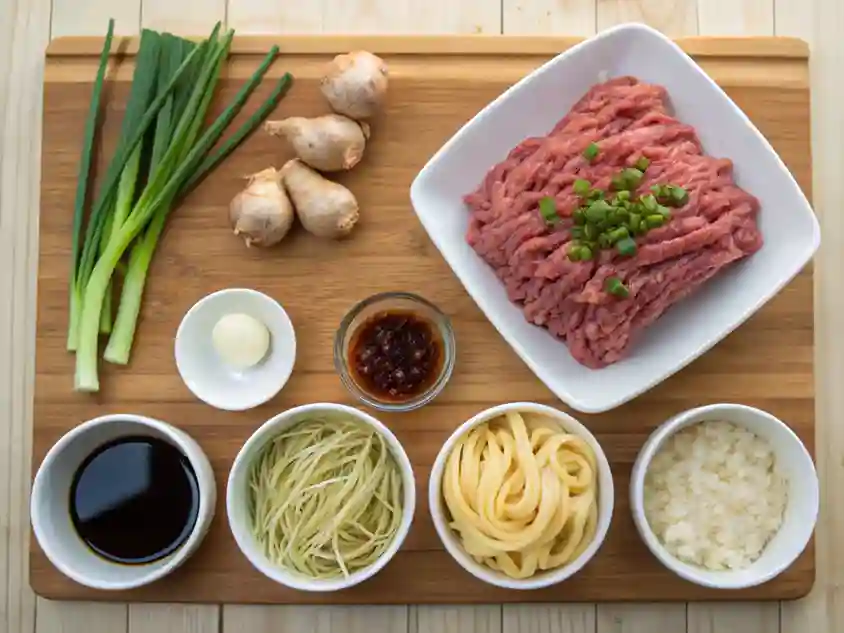
Before you jump into making Mongolian ground beef and noodles, gather your simple ingredients. This ensures a stress-free cooking process and helps you prep your stations efficiently. Here’s what you’ll need:
- Lean ground beef: Opt for 85/15 or 90/10 to keep things juicy yet not overly greasy. You can also blend in 2 tbsp of brown sugar for sweetness. ground beef with ground turkey if you prefer a lighter option, but stick to beef for that classic mongolian beef taste.
- Garlic: Freshly minced garlic is essential for depth of flavor. If you’re short on time, pre-minced varieties will do.
- Ginger: Both fresh ginger and ground ginger can work, but fresh adds the best kick. You’ll be adding ginger to the pan to bring the taste to life.
- Brown sugar: This sweetener balances the tangy soy sauce. It helps create that signature sweet and spicy element found in sweet and spicy Mongolian dishes.
- Soy sauce: If you want to reduce sodium levels, use low sodium soy sauce. You’ll still get robust flavor without overwhelming saltiness.
- Hoisin sauce: This thick, sweet-savory sauce elevates the depth of flavor and helps thicken the overall mixture.
- Sesame oil: Just a drizzle of rice vinegar to bring a nutty note to your dish. mongolian ground beef. This is completely optional, but it rounds out the dish perfectly.
- Green onion: Slice thinly for garnish. The fresh crunch contrasts nicely with the beef.
- Broccoli (optional): If you want extra veggies in your meal, consider added broccoli to make it more nutritious.
- Beef broth: Helps loosen the sauce and carry flavors throughout the dish.
- Cornstarch: Crucial to thicken the sauce quickly. It gives the beef mixture a luscious texture.
3. Step by Step Cooking Mongolian Ground Beef
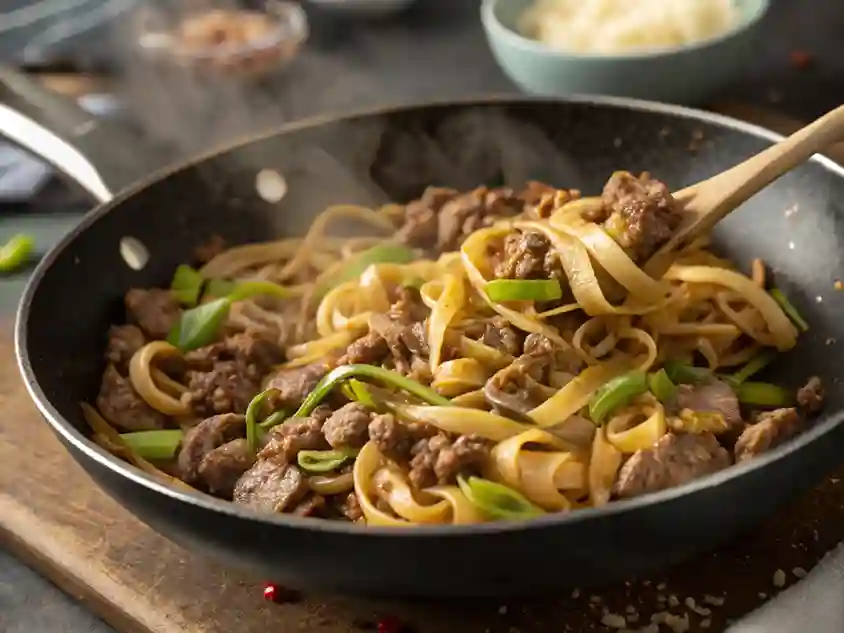
Let’s walk through how to cook the ground beef and bring everything together. This recipe is so straightforward, you’ll wonder why you didn’t make this recipe sooner:
Step 1: Prep the Sauce
In a small bowl, whisk together the key ingredients that will make your Mongolian sauce. This typically includes soy sauce, brown sugar, hoisin sauce, beef broth, a pinch of red pepper flakes, and some minced garlic plus ginger. For an even easier time, place your sauce in a small dish and keep it near your stove so you can quickly dish and pour into ground beef when needed.
Step 2: Cook the Beef
Start by taking your large skillet and heating it on medium-high heat. Add the ground meat—specifically, lean ground beef—and season with a little salt and pepper. Carefully brown the ground beef, stirring until it’s mostly cooked.
If you prefer to cook the beef further, you can drain excess fat for a lighter dish. While the beef is cooking, stir in minced garlic and ginger to the pan.
The combination of garlic and ginger is essential for that classic Mongolian taste.
Start by taking your large skillet and heating it on medium-high heat (or a skillet over medium-high heat, if that’s more comfortable). Add the ground meat—specifically, lean ground beef—and season with a little salt and pepper. Carefully brown the ground beef, stirring it around the skillet until it’s mostly cooked. If you prefer to cook the beef further, you can always drain excess fat for a lighter dish. While the beef is cooking, stir in minced garlic and ginger to the pan. The combination of garlic and ginger is a must for that classic taste.
Step 3: Combine & Thicken
Now that your beef is nearly done, it’s time to introduce your pre-mixed sauce. Dish and pour into ground beef while maintaining medium heat. Stir everything together so that each piece is coated.
Next, pour your cornstarch mixture (made by combining 1 teaspoon cornstarch with a bit of cold water) into the ground beef mixture. Let it simmer for 2-3 minutes so the sauce thickens. If you need extra liquid, splash in more broth. Add crushed red pepper flakes or a dash of black pepper for more heat if desired.
Step 4: Cook Your Noodles
Whether you choose rice noodles, egg noodles, or spaghetti, boil them according to package directions. This typically takes around minutes to make. Drain and set aside.
Alternatively, skip the noodle step and serve your Mongolian ground beef with white rice or cauliflower rice, depending on your preference.
4.Variations You Can Try with Mongolian Ground Beef
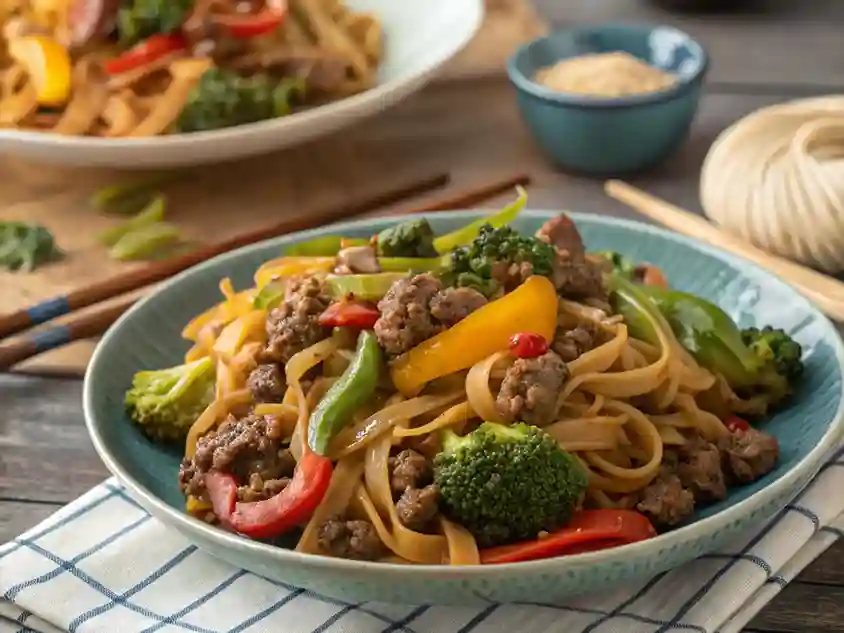
The beauty of making ground beef mongolian noodles at home is that you can tweak the recipe to suit your taste. If you’re looking for fresh spins, here are a few ideas:
Variation 1: Swap in Different Ground Meats
Although the recipe calls for made with ground beef, you can absolutely blend in ground turkey or ground pork for a lighter or more customized flavor. Some people even like combining half turkey, half beef. You can follow the recipe exactly except substitute or combine different meats. Just be sure not to overcook or dry out the mixture when you brown it in your skillet.
Variation 2: Add Veggies for a Health Boost
Feel free to introduce more vegetables to your mongolian ground beef. You’ve already added broccoli, but bell peppers, onions, zucchini, or carrots can also be tossed in. Sauté them in the same skillet over medium heat before or alongside the beef. This method not only pumps up the nutrients but can also add another layer of flavor to your spicy dish.
Variation 3: Adjust the Spice
If you like a sweet and spicy combo, increase the red pepper flakes or throw in some chili paste. Conversely, if you’re feeding kids or prefer milder flavors, cut back on any heat sources and let the brown sugar shine. Doing so will keep the dish mild yet still tangy and savory.
5. Tips for Perfecting Your Mongolian Ground Beef Noodles

Below are some pointers that can help you nail your Mongolian ground beef noodles every single time:
Tip 1: Don’t Overcook the Beef
When you brown or cook the ground beef, keep an eye on the texture. You want it fully browned but still juicy. Overcooking leads to a dry ground meat mixture, which impacts the final result. Once you see mostly no pink remaining, it’s a good time to move forward.
Tip 2: Control the Sauce Consistency
Because we use rice vinegar in our recipes. cornstarch and broth to thicken the sauce, you have the freedom to tailor it. If it’s too runny, let it simmer a bit longer. If it’s too thick, add an extra splash of beef broth or water until you reach the desired consistency. This way, the sauce coats the noodles without becoming overly gloopy.
Tip 3: Garnish Brightly
To truly finish off your Mongolian ground beef, top it with chopped green onion and maybe a sprinkle of sesame seeds. The bright color and mild bite of the onion complement the deep, sweet sauce. If you’re feeling adventurous, a drizzle of sesame oil (remember, keep it low sodium if you’re watching your salt intake overall) can bring everything together beautifully.
6. Serving Mongolian Ground Beef
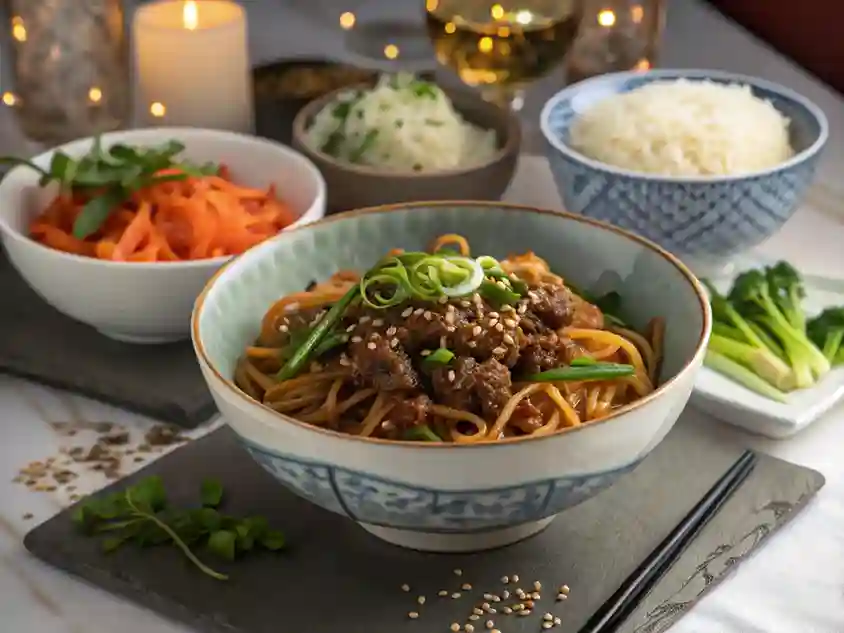
Serving Mongolian ground beef and noodles is a breeze. You can place the saucy beef mixture on top of your freshly cooked noodle or keep them separate if guests prefer to mix at the table.
Adding a side of stir-fried veggies or a simple salad can lighten up the plate, creating an easy and delicious dinner that’s guaranteed to impress.
For those who want a heartier meal, place the mongolian ground beef noodles in individual bowls, garnish with green onion, and allow each person to drizzle extra sauce or black pepper to taste. Alternatively, spoon it over white rice or jasmine rice if you prefer something closer to a classic takeout style. Some folks who made this last night mention that the leftovers are fantastic for lunch the next day as the flavors continue to meld.
Another perk is that you can always store leftover Mongolian ground beef in an airtight container for a few days. Simply reheat and enjoy. Many families love doubling the batch to have easy lunches throughout the week.
You’ll also get new recipes by mixing leftover beef into lettuce wraps or layering it on top of a stir-fried veggie medley.
7. Conclusion: Why You Should Make This Recipe Today
In summary, if you love the idea of quick, easy Mongolian flavors combined with ground beef but still want something that feels like an indulgence, you can’t go wrong with this approach. From the caramel notes of brown sugar to the tang of soy sauce, each bite brings you the best elements of Mongolian ground beef. Whether you enjoy it as Mongolian beef noodles, beef and noodles, or a topping over rice, you’ll be thrilled by how quickly you can whip this up with minimal fuss. This dish comes together in less than 30 minutes, so it’s ideal for a busy weeknight dinner that’s still brimming with taste. The fact that it’s made with ground protein means fewer steps—so you can focus on savoring the final result rather than toiling away in the kitchen.
Now that you know how to create your own ground beef mongolian noodles, it’s time to pick up those simple ingredients and give it a try! You’ll love how flexible and forgiving the recipe can be. Whether you choose noodles, rice, or a lighter veggie base, the bright flavors of ginger and garlic will stand front and center. Grab your skillet, gather your groceries, and make a batch of this family-friendly favorite tonight!
FAQs
1. What makes Mongolian beef different?
Mongolian beef is typically characterized by its sweet and tangy sauce, highlighting soy sauce, brown sugar, and fresh ginger. When you use mongolian ground beef instead of sliced flank steak, you retain all those signature flavors but save time on prep work. The sauce often includes hoisin sauce and sometimes chili flakes for a gentle kick, distinguishing it from other Asian-inspired stir-fries.
2. What is the rule for ground beef?
The key rule is to brown or cook the ground beef thoroughly until no pink remains, and then drain any excess fat if you prefer a lighter dish. Additionally, ensure you add flavor elements, like minced garlic and ginger, to lock in that classic Mongolian taste.
3. How long does Mongolian beef last in the fridge?
Properly stored in an airtight container, mongolian ground beef can last about 3 to 4 days in the fridge. Reheat gently in a skillet over medium or in the microwave, adding a splash of beef broth or water if the sauce has thickened too much.
4. What is the seasoning in Mongolian ground beef?
The primary seasonings include soy sauce, brown sugar, garlic, fresh ginger, and often hoisin sauce or sesame oil. Red pepper flakes or crushed red pepper flakes can be added for heat, while green onion brings a fresh and slightly piquant finish. You’ll often use low sodium or low sodium soy sauce plus a cornstarch slurry to thicken the sauce.
With that, you have all the essentials for a mouthwatering, savory dinner. Pick up your ingredients, make the sauce, and enjoy your hearty Mongolian ground beef noodles tonight!
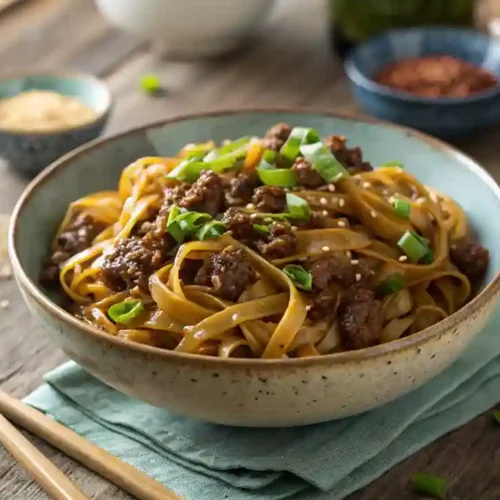
Easy Mongolian Ground Beef Noodle.
Ingredients
Lean ground beef:
- Opt for 85/15 or 90/10 to keep things juicy yet not overly greasy. You can also blend ground beef with ground turkey if you prefer a lighter option but stick to beef for that classic mongolian beef taste.
Garlic:
- Freshly minced garlic is essential for depth of flavor. If you’re short on time pre-minced varieties will do.
Ginger:
- Both fresh ginger and ground ginger can work but fresh adds the best kick. You’ll be adding ginger to the pan to bring the taste to life.
Brown sugar:
- This sweetener balances the tangy soy sauce. It helps create that signature sweet and spicy element found in sweet and spicy Mongolian dishes.
Soy sauce:
- If you want to reduce sodium levels use low sodium soy sauce. You’ll still get robust flavor without overwhelming saltiness.
Hoisin sauce:
- This thick sweet-savory sauce elevates the depth of flavor and helps thicken the overall mixture.
Sesame oil:
- Just a drizzle to bring a nutty note to your mongolian ground beef. This is completely optional but it rounds out the dish perfectly.
Green onion:
- Slice thinly for garnish. The fresh crunch contrasts nicely with the beef.
Broccoli (optional):
- If you want extra veggies in your meal consider added broccoli to make it more nutritious.
- Beef broth:
- Helps loosen the sauce and carry flavors throughout the dish.
Cornstarch:
- Crucial to thicken the sauce quickly. It gives the beef mixture a luscious texture.
Instructions
Step 1: Prep the Sauce
- In a small bowl, whisk together the key ingredients that will make your mongolian sauce. This typically includes soy sauce, brown sugar, hoisin sauce, beef broth, a pinch of red pepper flakes, and some minced garlic plus ginger. For an even easier time, place your sauce in a small dish and keep it near your stove so you can quickly dish and pour into ground beef when needed.
Step 2: Cook the Beef
- Start by taking your large skillet and heating it on medium-high heat (or a skillet over medium-high heat, if that’s more comfortable). Add the ground meat—specifically, lean ground beef—and season with a little salt and pepper. Carefully brown the ground beef, stirring it around the skillet until it’s mostly cooked. If you prefer to cook the beef further, you can always drain excess fat for a lighter dish. While the beef is cooking, stir in minced garlic and ginger to the pan. The combination of garlic and ginger is a must for that classic taste.
Step 3: Combine & Thicken
- Now that your beef is nearly done, it’s time to introduce your pre-mixed sauce. Dish and pour into ground beef while maintaining medium heat. Stir the beef and sauce together so that each piece of ground beef is coated. Next, you’ll take a small dish and pour your cornstarch mixture (made by combining 1 teaspoon cornstarch with a bit of cold water) right into the ground beef mixture. Let it simmer for 2-3 minutes so the sauce thickens. If you need extra liquid, splash in more broth. If you want more heat, add crushed red pepper flakes or a dash of black pepper.
Step 4: Cook Your Noodles
- Whether you choose rice noodles, egg noodles, or spaghetti, boil them according to package directions. This typically takes around minutes to make. Drain them and set aside. Alternatively, skip the noodle step and serve your mongolian ground beef with white rice or cauliflower rice, depending on your preference.
Notes
- Calories: 450 kcal
- Total Fat: 18 g
- Protein: 25 g
- Carbohydrates: 50 g
- Sodium: 800 mg
Categorization:
- Course: Main Course
- Cuisine: Asian Fusion
- Diet: Non-Vegetarian
- Method: Stir-Fry
- Keyword: Mongolian Ground Beef Noodles
- Skill Level: Easy
